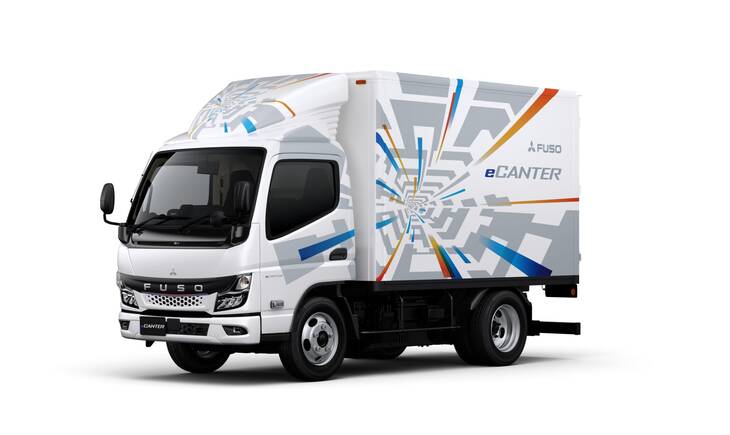March 9, 2023
- Customers in Japan can now order the fully remodeled all-electric eCanter
- Significantly expanded chassis lineup with 28 domestic variants, addressing a wide variety of business applications
- New battery modularization provides suitable driving ranges for various business applications, from last-mile deliveries to long-distance transportation with a range up to 324km
Kawasaki, Japan – Mitsubishi Fuso Truck and Bus Corporation (MFTBC; headquarters: Kawasaki City, Kanagawa Prefecture; President and CEO: Karl Deppen) has now opened orders for the fully remodeled all-new electric light-duty ‘eCanter’ truck in Japan. MFTBC sales companies and regional sales units across Japan have started accepting orders from domestic buyers as of March 9, 2023.
After launching the eCanter in 2017 as Japan’s first series-produced, all-electric light-duty truck* and introducing subsequent upgrades with advanced safety equipment, MFTBC unveiled in 2022 its latest model with a significant expansion to the vehicle lineup and options for driving range. This new model adopts the eAxle, which integrates the motor with the rear axle, enabling a reconfiguration of the drivetrain. The more compact drivetrain has made it possible to expand the chassis lineup from the current single option to a total of 28 variants for the Japanese market. A power take-off unit (ePTO) has also been adopted to support body applications such as tippers, car carriers, detachable body trucks, rear cranes, and garbage trucks.
The new eCanter has been engineered with a modularized battery design that can accommodate a range of one to three battery modules based on the wheelbase. The new model has secured a range varying from 99km to a maximum of 324km*** based on the vehicle type. It addresses a diverse range of transportation needs from last-mile delivery to long-distance transportation. Also equipped with new functions that reduce battery consumption during heating usage in cold climates, the eCanter has evolved significantly into an EV truck suitable for a variety of business needs.
Since its launch, the eCanter has been used in various applications across Japan, Europe, the United States, Australia, and New Zealand as a pioneer of electric trucking. Having now been operated over 7.6 million km by customers around the world, the low-noise, low-vibration, and locally emission-free eCanter has been tried and tested as an environmentally conscious and driver-friendly business choice. Reflecting MFTBC’s global operational experience over the past five years, customers in Japan will be supported by FUSO eMobility Solutions, a comprehensive set of services to aid their smooth transition into e-mobility.
“MFTBC is taking a leading role in the decarbonization of commercial vehicles for the global market. Our all-electric light-duty eCanter has come a long way since it was first introduced in 2017. Over the years we have received positive feedback from customers in Japan and all over the world, and can now offer a wide range of practical, reliable electric LDTs. Combined with a comprehensive set of support services and solutions, we make it easy for customers to experience the future of decarbonized transportation, today,” commented Karl Deppen, President and CEO of Mitsubishi Fuso Truck and Bus Corporation.
As an integral part of Daimler Truck, MFTBC is committed to the ambition of tank-to-wheel CO2 neutrality for commercial vehicles in Japan by 2039. As the international community accelerates its shift toward sustainability, the FUSO eCanter will continue to play a vital role in Daimler Truck’s roadmap to carbon-neutral transportation.
*As of Oct. 2017, as a Japanese commercial vehicle manufacturer
**The type of available variants will differ in each market. Dump body: compatible with a sub-frame mounting. Garbage truck mounting: compatible with push-out mounting.
***99km for S size battery vehicle with wide cab; 324km for L size battery vehicle with wide/EX wide cab. All values certified by the Ministry of Land, Infrastructure, Transport and Tourism. The range described in the press release applies only to Japanese model. The method of calculation of the driving range of the vehicle varies according to each market’s regulations.

